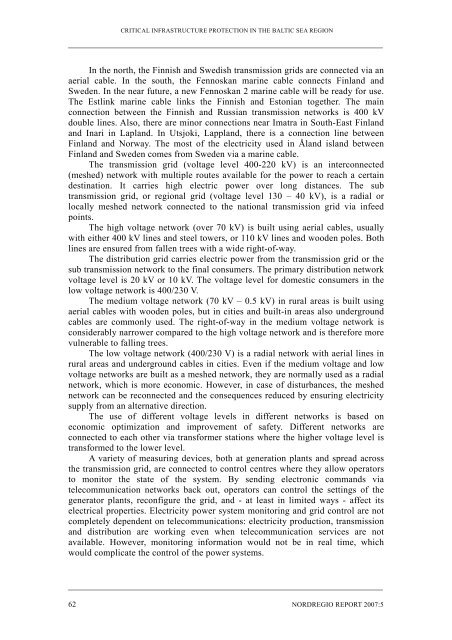Towards a Baltic Sea Region Strategy in Critical ... - Helsinki.fi
Towards a Baltic Sea Region Strategy in Critical ... - Helsinki.fi
Towards a Baltic Sea Region Strategy in Critical ... - Helsinki.fi
You also want an ePaper? Increase the reach of your titles
YUMPU automatically turns print PDFs into web optimized ePapers that Google loves.
CRITICAL INFRASTRUCTURE PROTECTION IN THE BALTIC SEA REGION<br />
In the north, the F<strong>in</strong>nish and Swedish transmission grids are connected via an<br />
aerial cable. In the south, the Fennoskan mar<strong>in</strong>e cable connects F<strong>in</strong>land and<br />
Sweden. In the near future, a new Fennoskan 2 mar<strong>in</strong>e cable will be ready for use.<br />
The Estl<strong>in</strong>k mar<strong>in</strong>e cable l<strong>in</strong>ks the F<strong>in</strong>nish and Estonian together. The ma<strong>in</strong><br />
connection between the F<strong>in</strong>nish and Russian transmission networks is 400 kV<br />
double l<strong>in</strong>es. Also, there are m<strong>in</strong>or connections near Imatra <strong>in</strong> South-East F<strong>in</strong>land<br />
and Inari <strong>in</strong> Lapland. In Utsjoki, Lappland, there is a connection l<strong>in</strong>e between<br />
F<strong>in</strong>land and Norway. The most of the electricity used <strong>in</strong> Åland island between<br />
F<strong>in</strong>land and Sweden comes from Sweden via a mar<strong>in</strong>e cable.<br />
The transmission grid (voltage level 400-220 kV) is an <strong>in</strong>terconnected<br />
(meshed) network with multiple routes available for the power to reach a certa<strong>in</strong><br />
dest<strong>in</strong>ation. It carries high electric power over long distances. The sub<br />
transmission grid, or regional grid (voltage level 130 – 40 kV), is a radial or<br />
locally meshed network connected to the national transmission grid via <strong>in</strong>feed<br />
po<strong>in</strong>ts.<br />
The high voltage network (over 70 kV) is built us<strong>in</strong>g aerial cables, usually<br />
with either 400 kV l<strong>in</strong>es and steel towers, or 110 kV l<strong>in</strong>es and wooden poles. Both<br />
l<strong>in</strong>es are ensured from fallen trees with a wide right-of-way.<br />
The distribution grid carries electric power from the transmission grid or the<br />
sub transmission network to the f<strong>in</strong>al consumers. The primary distribution network<br />
voltage level is 20 kV or 10 kV. The voltage level for domestic consumers <strong>in</strong> the<br />
low voltage network is 400/230 V.<br />
The medium voltage network (70 kV – 0.5 kV) <strong>in</strong> rural areas is built us<strong>in</strong>g<br />
aerial cables with wooden poles, but <strong>in</strong> cities and built-<strong>in</strong> areas also underground<br />
cables are commonly used. The right-of-way <strong>in</strong> the medium voltage network is<br />
considerably narrower compared to the high voltage network and is therefore more<br />
vulnerable to fall<strong>in</strong>g trees.<br />
The low voltage network (400/230 V) is a radial network with aerial l<strong>in</strong>es <strong>in</strong><br />
rural areas and underground cables <strong>in</strong> cities. Even if the medium voltage and low<br />
voltage networks are built as a meshed network, they are normally used as a radial<br />
network, which is more economic. However, <strong>in</strong> case of disturbances, the meshed<br />
network can be reconnected and the consequences reduced by ensur<strong>in</strong>g electricity<br />
supply from an alternative direction.<br />
The use of different voltage levels <strong>in</strong> different networks is based on<br />
economic optimization and improvement of safety. Different networks are<br />
connected to each other via transformer stations where the higher voltage level is<br />
transformed to the lower level.<br />
A variety of measur<strong>in</strong>g devices, both at generation plants and spread across<br />
the transmission grid, are connected to control centres where they allow operators<br />
to monitor the state of the system. By send<strong>in</strong>g electronic commands via<br />
telecommunication networks back out, operators can control the sett<strong>in</strong>gs of the<br />
generator plants, recon<strong>fi</strong>gure the grid, and - at least <strong>in</strong> limited ways - affect its<br />
electrical properties. Electricity power system monitor<strong>in</strong>g and grid control are not<br />
completely dependent on telecommunications: electricity production, transmission<br />
and distribution are work<strong>in</strong>g even when telecommunication services are not<br />
available. However, monitor<strong>in</strong>g <strong>in</strong>formation would not be <strong>in</strong> real time, which<br />
would complicate the control of the power systems.<br />
62 NORDREGIO REPORT 2007:5

















